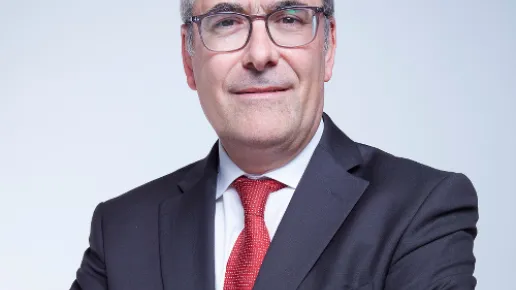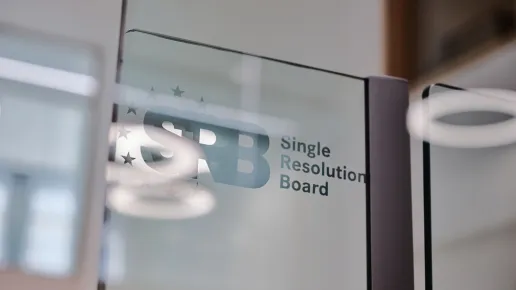Ms König, coalition talks are currently in progress in Berlin. What expectations do you have of the new federal government – for example on the subject of the Banking Union, which is also important for the SRB?
I hope we will keep the completion of the Banking Union on the agenda and continue to push ahead, even if at least one of the future coalition partners has so far been rather sceptical of the issue.
You mean the FDP.
However, progress in the Banking Union does not depend solely on the German side. In Germany, the European deposit insurance scheme (EDIS) is certainly a hot topic – even if there are a lot of false fears here.
What do you mean by that?
In my opinion, a few issues are mixed up in the debate on EDIS. No one wants to get their hands on the money in the private German deposit guarantee system. Nobody is putting an axe to the security systems of the cooperative banks or the savings banks. This is about the statutory deposit guarantee, and the savings banks must now build it up, following the compromise they have reached with the ECB. The cooperative banks have already built it up. I think the discussion here is moving back and forth between real issues and emotions. And, of course, it cannot be detached from the harmonisation of the insolvency rules for banks.
Why is the issue of insolvency rules so important to you?
I firmly believe in a European deposit guarantee scheme – but with uniform rules of the game for all. What it cannot be is a European pot that is used according to national rules. I would say: The ones who pay are the ones who set the rules of the game. And there must be clear European rules on this one. Nevertheless, to simply say that the Europeans want to use EDIS to get their hands on the German deposit guarantee scheme is a bit short-sighted.
But is it not the case that European rules have long existed in theory, but in practice, as soon as it comes to the resolution of a bank, special national leeway is regularly granted and precautionary recapitalisation is declared?
It’s even more complicated than that. Insolvency rules in Europe are not harmonised. Insolvency law is purely national law. In the EU, however, harmonisation of the deposit guarantee rules has been put on top of that. And the legislator has put a uniform European resolution law on top of the colourful carpet of national systems. Of course, in the case of Banco Popular in 2017, we have already demonstrated that the European resolution regime is working. On the other hand, there have also been creative national solutions in parallel, and not only in Italy.
Nord/LB has been recapitalised and in Italy Monte dei Paschi could be expensive for the taxpayers following the transfer of the Venetian people’s banks to Banca Intesa in 2017.
I will not comment on the situation of individual banks.
Nevertheless, the question is pressing: where do you see room for improvement in the current regulations?
It is fair to say that we have put into effect the resolution regime with its bail-in rules at a time when the banks had not yet built up the capital needed to do so. And so far, we have not managed to anchor the system in such a way that insolvency – that is, a very deep bail-in – is compared with resolution. The debate is still about a bail-out as a perceived alternative. The European Commission’s banking communication from 2013 is still in force, although it also requires a partial bail-in, but it otherwise follows different rules of the game from our system.
That hasn’t changed in the meantime?
Not to this day. Now we want to link changes with the introduction of the new crisis management framework, which is being discussed in the context of the Banking Union (the crisis management and deposit insurance framework). We have to tackle the issue, because otherwise we will always have a situation where the incentive systems are not the same. What is less painful when a bank gets into a trouble: a bail-in that annoys many people, or a bail-out that taxpayers may quickly forget about? I would still say that the bail-out is the worst of all solutions, because it must be paid for by the young generation in the future and the resolution regime has just been created to prevent this.
What exactly is this new crisis management about?
The first is to get a solid, unified solution for all depositors in the banking union. Secondly, the rules on insolvency must be harmonised throughout Europe. Personally, I do not I think I will see a major insolvency law reform in my lifetime. But perhaps specific rules can be established for financial institutions only. Overall, it is complicated because many issues are interrelated in the crisis framework. The reduction of the risks from distressed loans plays a role here, as does the handling of sovereign debt, i.e. banks’ exposure to the respective Member State or other states. However, we need to make progress here and complete the banking union, also in order to have a single European banking market in the end. Unfortunately, we have less of a European market today than before the financial crisis, because many banks have withdrawn internationally. But you can only have really strong European banks if you have a single European market.
Why are they important?
A few strong European banks are already doing well for an industrial-state association like the EU. Otherwise, you would ultimately always have to be dependent on American banks for certain things. In which EU country a strong bank would be based is not really a concern to me.
What role does the Single Resolution Board actually play in the discussion about a new crisis management system and a possibly closer link between supervision, resolution and deposit guarantee? Do you hope that the SRB will be given additional powers?
The moment we start talking about what the SRB could do, any proposal would be dead, because it would immediately be said that we simply want to strengthen our own authority. However, Deutsche Bank CEO Christian Sewing recently said that a deposit guarantee institution modelled on the US FDIC would suit us well in Europe.
Do you see it that way too?
Yes, but I can also see the problems with this proposal. The difference is that the US is a country with very strong federal states. In the European Banking Union, on the other hand, there are now 21 independent Member States. Nevertheless, in the long term, building a European FDIC would be the right way to go. Such an authority would then be responsible for all banks. And after a decision about ‘failing or likely to fail’, there are only two options for a faltering bank: either this bank is simply resolved – which we usually see as insolvency – or it’s a big bank where you can’t take this step so quickly. This then leads to the bank’s resolution and subsequent restructuring. Both are provided by the FDIC.
However, this would not solve the problem with the 21 different insolvency laws.
That’s true. The idea of establishing a European FDIC does not free us from the question of whether the insolvency rules need to be harmonised. In addition, even with such a new authority, the losses would have to be allocated to a bank. If we continue thinking about the idea of a large authority like the FDIC, we could also combine the bank resolution fund and the deposit guarantee, couldn’t we?
A European fund, which could then simultaneously be used to guarantee deposits and support resolution, would then certainly have to be considered. It must also be seen that, in the case of a large bank where the deposit guarantee scheme is now in effect, there is, as a rule, no chance of a deposit guarantee being provided with the available capital and money from the bank resolution fund. We must stabilise the institution first and then proceed with resolution. For banks, a large European fund might also be a little cheaper, as it provides synergies. In any case, such a fund would also provide additional flexibility.
The head of Deutsche Bank is already at odds with the costs of today’s Single Resolution Fund and argues, among other things, that the SRF is now much larger than originally planned. Do you have any sympathy with what he is saying?
In a crisis, of course, it is better to have the money in the pot and not to have to look for it. But his argument is correct in that the 1% of covered deposits that the fund is supposed to have were originally forecast to be around EUR 55 billion in an initial projection in 2013. The covered deposits have developed far more positively than expected since then, and have also risen significantly again as a result of the pandemic. I therefore think that we will end up with EUR 75 billion rather than EUR 70 billion in the bank resolution fund.
Are you in favour of a cap on the sum?
The SRB is not the right place to which to address this question: you should ask the Commission and the Council of the EU about this. We are only implementing the text of the law. However, the Member States need unanimity in order to change something about this. And that makes it relatively unlikely that we will see a change in the SRF volume in the short term. We also do not know whether this increase in covered deposits will continue or, at least, level off significantly. In any case, I was annoyed last year that during the pandemic, the European Banking Association (EBF) lobbied against the suspension of the dividend payment while simultaneously lobbying for the suspension of payments to the SRF. This was contradictory.
Various court cases are pending because of the contributions.
Yes, there are about 80 cases in total. It is known, for example, that Landesbank Baden-Württemberg (LBBW) had taken legal action. The first cases were lost in 2016 purely on a technicality. After we sent out our contribution certificates for 2021 in July, the ECJ has once again confirmed the legal basis. However, the SRB must give better reasons for its decision, so we are currently in the process of making a new decision for LBBW. But it will contain the same numbers as before. Up to now, the cases have been more concerned with formal technicalities rather than the substance of the calculations. These will be on the agenda from next year. I assume that these proceedings will continue to keep us busy for a while.
Could this again fundamentally call the bank resolution fund into question?
With the best will in the world, I cannot imagine that.
Does the reform of the European Stability Mechanism, which is currently still being ratified and which, from 2022, also provides for a backstop for the bank resolution fund, facilitate the work of the SRB?
I believe that this last resort will have a major impact. It dispels concerns that the resolution regime may prove inadequate if a major bank were to be hit. I hope, of course, that we will never need the backstop. In this context, it is particularly important, with regard to concerns in Germany, to emphasise once again that the backstop of the ESM is a credit line and the SRB has to repay this credit when it is drawn down.
The fact that the ESM is now also taking risks in the banking sector had triggered discussions in Germany…
Yes, but in its old form, the ESM also had the possibility of direct bank recapitalisation. This will now be removed in the course of the reform. And if you compare the direct recapitalisation of a bank with a loan that we would use for a single bank, but which 3 000 banks ultimately guarantee in repayment because they all pay into our fund, then I think the risk for the ESM will be much lower in the future. In addition, the use of the backstop is already subject to a number of strict conditions.
Another field where progress is very tough is the question of how a bank in resolution is provided with liquidity. You have been calling for the ECB to provide liquidity as a solution for years, but the ECB does not want to be pushed into this role.
The issue is not just tough: it is über-tough. All sides are aware of the need to solve the problem. The disagreement is about how to do so. There are different models. We would favour a supply of liquidity by the ECB, because it is the only authority that can credibly provide unlimited resources. However, the ECB insists on 100% collateralisation of this liquidity in accordance with its contracts. But then we could theoretically take it over ourselves right away.
What would the alternatives be?
There was the famous Fiat model, named after its inventors Finland and Austria. This provides for the SRF to issue bonds for which the banks’ contributions serve as collateral, thus ensuring liquidity. The only problem is that these contributions already serve the ESM as a security for the backstop, and they leave themselves poorly served. And the third option being discussed at the moment is the EU budget as a possible guarantee. I don’t know how realistic that is. I continue to believe that the most sensible solution would be for the liquidity to come from the Central Bank and for us to give it a first-loss guarantee. This would ultimately make the banking system liable.
Who would absorb any losses beyond that?
That is open, because no one has yet agreed to do so. I am still completely relaxed on this matter, because I lack any idea of how, if it’s a weekend, we first have to wonderfully orchestrate a large bank resolution along with capital and structure, but then on Sunday afternoon we still have to push the bank into national insolvency due to lack of liquidity. You would not let that happen. I would rather like to see people think in advance about how to deal with such a situation. The British and the Americans have corresponding concepts. Unfortunately, we are not making any progress at all on this issue.
Does that still sound clear, or there already disillusionment?
I would call it rather frustrated, but nevertheless determined and persistent. The issue must be resolved, so it remains on the agenda. And if someone has a better idea than us, they are very welcome to put it forward – it just has to work quickly and reliably.
Another unresolved issue is the home/host issue, i.e. conflicts of interest between the authorities of the states where a bank’s headquarters are located and the states where its subsidiaries are located.
There are a number of practical questions associated with the home/host problem, because in the end, insolvency law always affects a company or an individual bank, not a banking group. But how do you make sure that capital goes where it belongs? There is still a great deal of concern about what might happen if this fails. In the recent reform of the Bank Recovery and Resolution Directive, the so-called host countries have also incorporated a number of types of collateral, including a very high internal MREL, i.e. capital that, in the event of an emergency, must be available at the individual subsidiaries in terms of own funds and eligible liabilities. Large banking groups are, of course, very critical of the need to maintain liquidity and capital in each of their units.
How can this be solved?
The first step must be to ensure that a resolution is occurs at the parent company and that the subsidiaries remain solvent. This is the meaning of the so-called Single Point of Entry concept, which applies to the majority of the banking group. Banks may also consider converting subsidiaries into branches to release liquidity. Then some of these rules do not apply. In my view, this is, in any case, an issue for which we must find a solution if we want a European banking market.
How optimistic are you that this will work?
I’m pretty determined about that, too. I don’t know how long it will take. In any case, we should not wait until the next crisis comes along. But we also have successes…
Which ones?
For example, it has been said for years that it is impossible for small and medium-sized banks in particular to form MREL. Now that there are binding targets for 2022, we see that these banks are also meeting these targets. The market is wide open, and even banks that do not have an investment grade rating can borrow money from the market at good prices. Now it could be said that this indicates that the market is very risk-aware at the moment. But still, progress is being made.
How will the conclusion of Basel III change the SRB’s MREL requirements? These depend on the respective risk assets of a bank, which will increase with Basel III.
Whenever the capital requirements increase, the need for MREL logically also increases.
How much?
That cannot be realistically estimated at the moment. First of all, we are now awaiting the outcome of the European Commission’s proposal in the political process. And whether the increase in capital requirements will then have a full impact on MREL is also yet to be seen. We already have the option not to demand full MREL from a bank.
Ms König, at the end of next year, just before Christmas 2022, your mandate as the SRB Chair will end. Given the many unresolved issues we have just talked about, could you imagine extending it again for a while?
That’s not possible. And that is why it is now up to the European Commission to launch a selection procedure and find a successor. I hope it does that in time: a selection procedure like this takes time. And I very much hope that, unlike the recent replacement of the ESMA Chair, this will happen quickly and without too much wrangling. The post of our board member, Boštjan Jazbec, will also be vacated three months later, so I suppose the Commission will combine both procedures. I would like to see the succession settled in autumn of next year.
What else do you want to achieve by the end of your term of office?
I would like the banks to be resolvable as planned by the end of 2023. I will not be in office in 2023, but I will work on it until the end of my term. I don’t want to have to be told later that something is no longer possible because one thing or another should have been done in 2021 or 2022. A second issue, of course, is the development of the bank resolution fund. Thirdly, I would of course be pleased if, in the current political debate on the Banking Union, we might not perhaps have a roadmap until I leave, but at least know what we want to achieve and in what order. And then I would do exactly what I did after my time as President of BaFin (the German Federal Financial Supervisory Authority): I will not write nasty letters and will not give my successor unsolicited advice and support.
--------------------------------------------
Interview by Bernd Neubacher and Andreas Heitker.
The original interview appeared in Boersen Zeitung on the 17th November 2021 and can be accessed here: https://www.boersen-zeitung.de/banken-finanzen/unfortunately-we-are-not-making-any-progress-at-all-on-this-issue-4ab478bc-46fb-11ec-bf4a-dccaf4fffe05
Contact our communications team
Recent news

The SRB recently published two important documents clarifying its expectations of banks regarding operational resolvability: the Operational guidance...

The body responsible for managing banks in crisis in Europe is celebrating its 10th anniversary and claims that Popular's 2017 resolution has been...

In last June, Parliament and Council have clinched a political deal that is applicable to all the EU member states, and which can be seen as a step...



